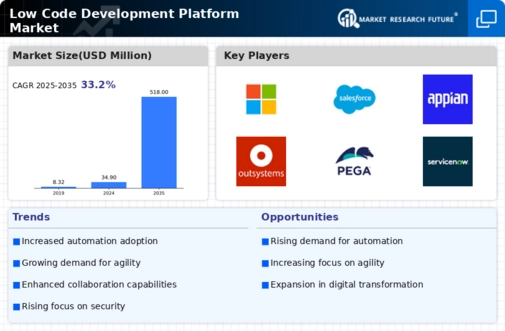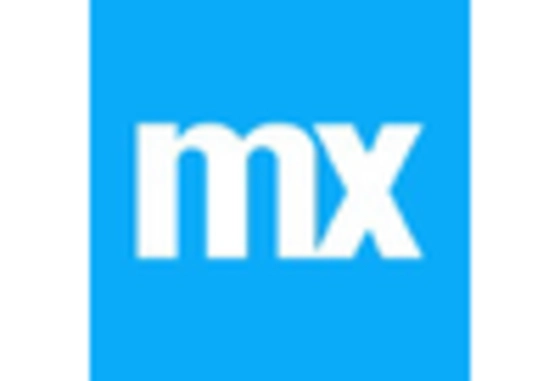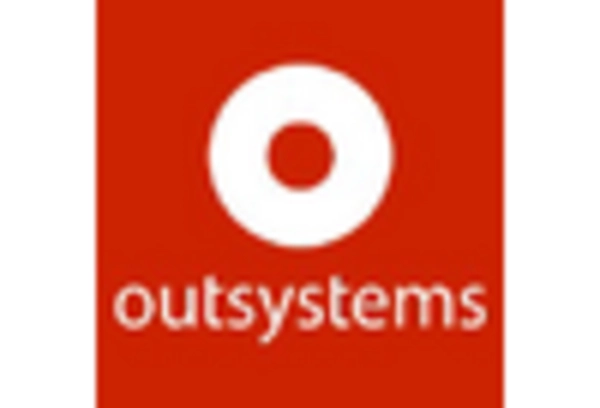Solution
Mobile Solutions
Web Solutions
Service
Professional Services
Managed Services
General Purpose Platform
Database App Platform
Process App Platform
Request Handling Platform
Others
On – Premises
On Cloud
Public Cloud
Private Cloud
Hybrid Cloud
Small and Medium Enterprise
Large Enterprise
Retail and E-Commerce
Healthcare
Media & Entertainment
BFSI
IT & Telecommunication
Government
Others
Solution
Mobile Solutions
Web Solutions
Service
Professional Services
Managed Services
General Purpose Platform
Database App Platform
Process App Platform
Request Handling Platform
Others
On – Premises
On Cloud
Public Cloud
Private Cloud
Hybrid Cloud
Small and Medium Enterprise
Large Enterprise
Retail and E-Commerce
Healthcare
Media & Entertainment
BFSI
IT & Telecommunication
Government
Others
Solution
Mobile Solutions
Web Solutions
Services
Professional Service
Managed Services
General Purpose Platform
Database App Platform
Process App Platform
Request Handling Platform
Others
On Premise
On Cloud
Public Cloud
Private Cloud
Hybrid Cloud
Small and Medium Enterprise
Large Enterprise
Retail and E-Commerce
Healthcare
Media & Entertainment
BFSI
IT & Telecommunication
Government
Others
Solution
Mobile Solutions
Web Solutions
Services
Professional Service
Managed Services
General Purpose Platform
Database App Platform
Process App Platform
Request Handling Platform
Others
On Premise
On Cloud
Public Cloud
Private Cloud
Hybrid Cloud
Small and Medium Enterprise
Large Enterprise
Retail and E-Commerce
Healthcare
Media & Entertainment
BFSI
IT & Telecommunication
Government
Others
Solution
Mobile Solutions
Web Solutions
Services
Professional Service
Managed Services
General Purpose Platform
Database App Platform
Process App Platform
Request Handling Platform
Others
On Premise
On Cloud
Public Cloud
Private Cloud
Hybrid Cloud
Small and Medium Enterprise
Large Enterprise
Retail and E-Commerce
Healthcare
Media & Entertainment
BFSI
IT & Telecommunication
Government
Others
Solution
Mobile Solutions
Web Solutions
Service
Professional Services
Managed Services
General Purpose Platform
Database App Platform
Process App Platform
Request Handling Platform
Others
On – Premises
On Cloud
Public Cloud
Private Cloud
Hybrid Cloud
Small and Medium Enterprise
Large Enterprise
Retail and E-Commerce
Healthcare
Media & Entertainment
BFSI
IT & Telecommunication
Government
Others
Solution
Mobile Solutions
Web Solutions
Services
Professional Service
Managed Services
General Purpose Platform
Database App Platform
Process App Platform
Request Handling Platform
Others
On Premise
On Cloud
Public Cloud
Private Cloud
Hybrid Cloud
Small and Medium Enterprise
Large Enterprise
Retail and E-Commerce
Healthcare
Media & Entertainment
BFSI
IT & Telecommunication
Government
Others
Solution
Mobile Solutions
Web Solutions
Services
Professional Service
Managed Services
General Purpose Platform
Database App Platform
Process App Platform
Request Handling Platform
Others
On Premise
On Cloud
Public Cloud
Private Cloud
Hybrid Cloud
Small and Medium Enterprise
Large Enterprise
Retail and E-Commerce
Healthcare
Media & Entertainment
BFSI
IT & Telecommunication
Government
Others
Solution
Mobile Solutions
Web Solutions
Services
Professional Service
Managed Services
General Purpose Platform
Database App Platform
Process App Platform
Request Handling Platform
Others
On Premise
On Cloud
Public Cloud
Private Cloud
Hybrid Cloud
Small and Medium Enterprise
Large Enterprise
Retail and E-Commerce
Healthcare
Media & Entertainment
BFSI
IT & Telecommunication
Government
Others
Solution
Mobile Solutions
Web Solutions
Services
Professional Service
Managed Services
General Purpose Platform
Database App Platform
Process App Platform
Request Handling Platform
Others
On Premise
On Cloud
Public Cloud
Private Cloud
Hybrid Cloud
Small and Medium Enterprise
Large Enterprise
Retail and E-Commerce
Healthcare
Media & Entertainment
BFSI
IT & Telecommunication
Government
Others
Solution
Mobile Solutions
Web Solutions
Services
Professional Service
Managed Services
General Purpose Platform
Database App Platform
Process App Platform
Request Handling Platform
Others
On Premise
On Cloud
Public Cloud
Private Cloud
Hybrid Cloud
Small and Medium Enterprise
Large Enterprise
Retail and E-Commerce
Healthcare
Media & Entertainment
BFSI
IT & Telecommunication
Government
Others
Solution
Mobile Solutions
Web Solutions
Services
Professional Service
Managed Services
General Purpose Platform
Database App Platform
Process App Platform
Request Handling Platform
Others
On Premise
On Cloud
Public Cloud
Private Cloud
Hybrid Cloud
Small and Medium Enterprise
Large Enterprise
Retail and E-Commerce
Healthcare
Media & Entertainment
BFSI
IT & Telecommunication
Government
Others
Solution
Mobile Solutions
Web Solutions
Services
Professional Service
Managed Services
General Purpose Platform
Database App Platform
Process App Platform
Request Handling Platform
Others
On Premise
On Cloud
Public Cloud
Private Cloud
Hybrid Cloud
Small and Medium Enterprise
Large Enterprise
Retail and E-Commerce
Healthcare
Media & Entertainment
BFSI
IT & Telecommunication
Government
Others
Solution
Mobile Solutions
Web Solutions
Service
Professional Services
Managed Services
General Purpose Platform
Database App Platform
Process App Platform
Request Handling Platform
Others
On – Premises
On Cloud
Public Cloud
Private Cloud
Hybrid Cloud
Small and Medium Enterprise
Large Enterprise
Retail and E-Commerce
Healthcare
Media & Entertainment
BFSI
IT & Telecommunication
Government
Others
Solution
Mobile Solutions
Web Solutions
Services
Professional Service
Managed Services
General Purpose Platform
Database App Platform
Process App Platform
Request Handling Platform
Others
On Premise
On Cloud
Public Cloud
Private Cloud
Hybrid Cloud
Small and Medium Enterprise
Large Enterprise
Retail and E-Commerce
Healthcare
Media & Entertainment
BFSI
IT & Telecommunication
Government
Others
Solution
Mobile Solutions
Web Solutions
Services
Professional Service
Managed Services
General Purpose Platform
Database App Platform
Process App Platform
Request Handling Platform
Others
On Premise
On Cloud
Public Cloud
Private Cloud
Hybrid Cloud
Small and Medium Enterprise
Large Enterprise
Retail and E-Commerce
Healthcare
Media & Entertainment
BFSI
IT & Telecommunication
Government
Others
Solution
Mobile Solutions
Web Solutions
Services
Professional Service
Managed Services
General Purpose Platform
Database App Platform
Process App Platform
Request Handling Platform
Others
On Premise
On Cloud
Public Cloud
Private Cloud
Hybrid Cloud
Small and Medium Enterprise
Large Enterprise
Retail and E-Commerce
Healthcare
Media & Entertainment
BFSI
IT & Telecommunication
Government
Others
Solution
Mobile Solutions
Web Solutions
Services
Professional Service
Managed Services
General Purpose Platform
Database App Platform
Process App Platform
Request Handling Platform
Others
On Premise
On Cloud
Public Cloud
Private Cloud
Hybrid Cloud
Small and Medium Enterprise
Large Enterprise
Retail and E-Commerce
Healthcare
Media & Entertainment
BFSI
IT & Telecommunication
Government
Others
Solution
Mobile Solutions
Web Solutions
Services
Professional Service
Managed Services
General Purpose Platform
Database App Platform
Process App Platform
Request Handling Platform
Others
On Premise
On Cloud
Public Cloud
Private Cloud
Hybrid Cloud
Small and Medium Enterprise
Large Enterprise
Retail and E-Commerce
Healthcare
Media & Entertainment
BFSI
IT & Telecommunication
Government
Others
Solution
Mobile Solutions
Web Solutions
Services
Professional Service
Managed Services
General Purpose Platform
Database App Platform
Process App Platform
Request Handling Platform
Others
On Premise
On Cloud
Public Cloud
Private Cloud
Hybrid Cloud
Small and Medium Enterprise
Large Enterprise
Retail and E-Commerce
Healthcare
Media & Entertainment
BFSI
IT & Telecommunication
Government
Others
Solution
Mobile Solutions
Web Solutions
Services
Professional Service
Managed Services
General Purpose Platform
Database App Platform
Process App Platform
Request Handling Platform
Others
On Premise
On Cloud
Public Cloud
Private Cloud
Hybrid Cloud
Small and Medium Enterprise
Large Enterprise
Retail and E-Commerce
Healthcare
Media & Entertainment
BFSI
IT & Telecommunication
Government
Others
Solution
Mobile Solutions
Web Solutions
Service
Professional Services
Managed Services
General Purpose Platform
Database App Platform
Process App Platform
Request Handling Platform
Others
On – Premises
On Cloud
Public Cloud
Private Cloud
Hybrid Cloud
Small and Medium Enterprise
Large Enterprise
Retail and E-Commerce
Healthcare
Media & Entertainment
BFSI
IT & Telecommunication
Government
Others
Solution
Mobile Solutions
Web Solutions
Services
Professional Service
Managed Services
General Purpose Platform
Database App Platform
Process App Platform
Request Handling Platform
Others
On Premise
On Cloud
Public Cloud
Private Cloud
Hybrid Cloud
Small and Medium Enterprise
Large Enterprise
Retail and E-Commerce
Healthcare
Media & Entertainment
BFSI
IT & Telecommunication
Government
Others
Solution
Mobile Solutions
Web Solutions
Services
Professional Service
Managed Services
General Purpose Platform
Database App Platform
Process App Platform
Request Handling Platform
Others
On Premise
On Cloud
Public Cloud
Private Cloud
Hybrid Cloud
Small and Medium Enterprise
Large Enterprise
Retail and E-Commerce
Healthcare
Media & Entertainment
BFSI
IT & Telecommunication
Government
Others
Solution
Mobile Solutions
Web Solutions
Services
Professional Service
Managed Services
General Purpose Platform
Database App Platform
Process App Platform
Request Handling Platform
Others
On Premise
On Cloud
Public Cloud
Private Cloud
Hybrid Cloud
Small and Medium Enterprise
Large Enterprise
Retail and E-Commerce
Healthcare
Media & Entertainment
BFSI
IT & Telecommunication
Government
Others
Solution
Mobile Solutions
Web Solutions
Service
Professional Services
Managed Services
General Purpose Platform
Database App Platform
Process App Platform
Request Handling Platform
Others
On – Premises
On Cloud
Public Cloud
Private Cloud
Hybrid Cloud
Small and Medium Enterprise
Large Enterprise
Retail and E-Commerce
Healthcare
Media & Entertainment
BFSI
IT & Telecommunication
Government
Others
Solution
Mobile Solutions
Web Solutions
Services
Professional Service
Managed Services
General Purpose Platform
Database App Platform
Process App Platform
Request Handling Platform
Others
On Premise
On Cloud
Public Cloud
Private Cloud
Hybrid Cloud
Small and Medium Enterprise
Large Enterprise
Retail and E-Commerce
Healthcare
Media & Entertainment
BFSI
IT & Telecommunication
Government
Others
Solution
Mobile Solutions
Web Solutions
Services
Professional Service
Managed Services
General Purpose Platform
Database App Platform
Process App Platform
Request Handling Platform
Others
On Premise
On Cloud
Public Cloud
Private Cloud
Hybrid Cloud
Small and Medium Enterprise
Large Enterprise
Retail and E-Commerce
Healthcare
Media & Entertainment
BFSI
IT & Telecommunication
Government
Others
Solution
Mobile Solutions
Web Solutions
Services
Professional Service
Managed Services
General Purpose Platform
Database App Platform
Process App Platform
Request Handling Platform
Others
On Premise
On Cloud
Public Cloud
Private Cloud
Hybrid Cloud
Small and Medium Enterprise
Large Enterprise
Retail and E-Commerce
Healthcare
Media & Entertainment
BFSI
IT & Telecommunication
Government
Others

















Leave a Comment